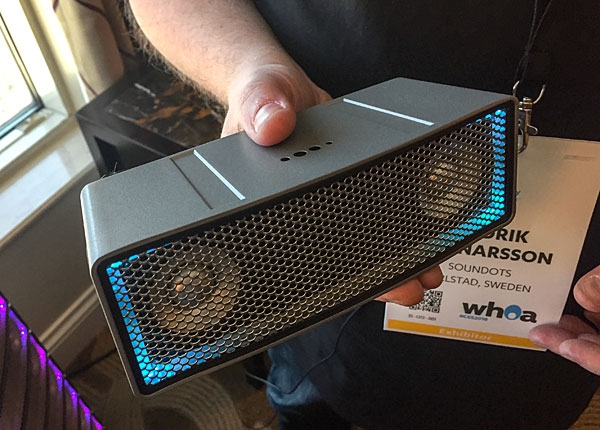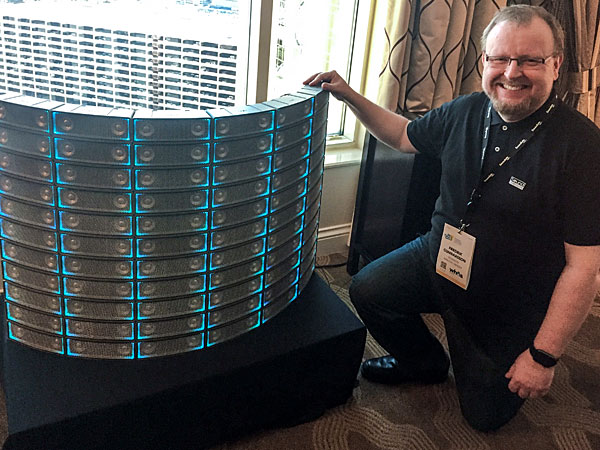| Columns Retired Columns & Blogs |
How about 2 arrays for stereo? Sonos can do it. ;-)

"What we have here is a scalable speaker system," Soundots Frederik Gunnarsson begins. "You can scale the performance depending on how many units you put together. You can put them on top of each other . . ." And as Gunnarsson said this he moved two speakers next to each other which then magnetically snapped together and docked, their lights flashing a different color and then turning blue again as they both start playing the same music.
Gunnarsson then explains that "as this happens, the SPL is increasing, and we can push lower in frequency." He then adds a third speaker which does the flash and then starts playing with the other two as the depth of sound increases. The speakers have a hefty feel, are quite well built and inside, the battery is claimed to last up to eight hours. Each speaker costs $290 and is available online now.
How the speakers synchronize is ingenious. If you look closely at the top photo, you can see some dark round dots on the top center of the speaker. The same dots are on the bottom and each side. These are infra-red transmitters/receivers and are how the speakers communicate with each other when they are brought in proximity.
"Each speaker adds a 6dB doubling SPL output," Gunnarsson continues. In the photo below, 66 units are synced and playing in the room, and Gunnarsson says you can add a lot more as they create a mesh-type network. One of the units will act as master and take a Bluetooth or optical input that tops out at 24/192, and then send that signal to all the others.

Which all reminds me of an afternoon in the early nineties at our audio store in San Luis Obispo, CA. Near the front we had a wall about 20 feet long and 8 feet high where we displayed the 20-30 portable all-in-one players popular in those days. One slow day, we decided to tune all of their radios to the local college station (KCPR) and crank 'em all the way up. It was a deafening but surprisingly rich sound (and awesome) which we quickly dubbed "The Wall O' Blasters" or "The WOB" for short. Several employees from the Benetton shop next door (we were separated by a 2 foot thick brick wall!) came running over to see what had happened. It was glorious.
Much of this same effect is heard when dozens of these Soundots are stacked up and cranked as a Wall O' Dots (The WOD?). Instead of just a louder version of the single unit, a synergy kicks in that lends a big sound with deeper bass and natural tonality than seems impossible from such small drivers. Stereo imaging doesn't really work in this huge setup, but still, the sound is surprisingly impressive.

How about 2 arrays for stereo? Sonos can do it. ;-)

66 units at $290 each, $19140! That is more than a pair of Kii Three speakers. Which would you rather have in your room? Interesting concept, not sure how many units for the optimal price/performance.

Point taken but I was more interested in the possibility of such an arrangement than the practicality.

Hi Kal. My comment wasn't meant to demean your question in any way, just a general comment in terms of price/performance ratio and looking at the context from a different angle.
Cheers!

A quality modular system is something lots of people yearn for. I've always wondered why there weren't more of these modular designs, from the music player all the way through to the speakers. Hi-fi components have always been that to some extent, but the ability to break down individual components into smaller less feature-rich pieces has rarely materialized. Cost probably is a factor, since each sub-component etc. would have to be packaged and powered, etc.

We used to specialize in synching up cars and blasters in the middle of nowhere as a kid.
We could be out of sight of any civilization and have several dozen 'units' of all types playing the same stations, it rocked. Kind of surreal walking on a desert playa from place to place with a "miles wide" soundstage and atmosphere.
When drive-in movie places first went to sound via your car radio, our local drive-in would have dances with everybody's cars playing the same music.
Ah, and the dorms with every room playing AOR from KOZZ 104.5 all at the same time.
My son does it in his neighborhood with every house tuning into the same internet playlist all at once. It is eerily sublime.
Then we hit the age of stacked Advents.
Hint: two pair of stacked AR 90s = one pair of Duntech Sovereigns.
"Hive sound" is great!

"Each speaker adds a 6dB doubling SPL output," Gunnarsson continues
They certainly do not! The first one, yes. How to add same sources:
LP_sum = 20*log10(sum(10^(LP_k/20))) | k = 1:N where N is number of sources
Using 66 speakers one gets an addition of +36.4dB, instead of using just one.

I want my 396 extra dB!
One fun thing might be to simply get a big group of people to all get a couple and then use them for gatherings.
A Saturn 5 rocket right up close can go 220 dB.
Krakatoa was 310 dB, rupturing ear drums 40 miles away!
Mwa ha ha ha with my 396 dB!

Think I got miss quoted on this one. Thanks Jon for acknowledging this. I may have said that it is 6dB per DOUBLING of units. 1->2, 2->4, 4->8, 8->16... and so on, making up these 36dB as it is ruffly doubled 6 times. Cheers, Fredrik Gunnarsson

my take on this (and, obviously I could be wrong) would be to have this type of system for parties/non-critical listening which seems like an interesting idea. Set up as desired for the occasion. Depending on the number of Soundots required, say, for example 16, it might be a bit of a chore to recharge them all, depending what you have on hand to charge them (perhaps more equipment needed for charging...?) I'm also assuming the 8 hours is playback at an optimal level.
Cheers,
Terry

charge all 66 of them.
Yikes

In 1992, the main store had a wall of Large Advent reboots. These were the ones Advent's owner in the early '90s (Jensen) briefly reintroduced to commemorate the 25th Anniversary of the best-selling speaker of all time. I'd link to Stereophile's review of the Anniversary version, but I can't find it because the search function on these sites remains mostly worthless.
The store where I worked in St. Louis (Hi FI Fo Fum) was a major reason for the original speaker's success in the 1970s, and for the subsequent successes Boston Acoustics enjoyed in the 80s/early '90s. And by that, I mean Fum was a bonafide star from both Kloss' and Petit's perspectives.
The 1992 Wall also recreated a display Fum once did with Large Advents around 20 years prior. Wall of Advents.
At the same time, over at an outpost store in Fairview Heights, Ill, we had a promotion for some Bostons, I guess they were A100s or perhaps A150s. Wall of Bostons. 30-40? Our Wall made sound :)
Of course, it had to be wired in a series/parallel configuration so as to not shut down the amp. I think the NAD 2600 was seeing 4-6 ohms, maybe a little less? Just enough to compel the amp to give its all. (The "demos" never lasted very long ... ) The only other piece of the "system" was a CD player with remote controllable volume.
People would come in, look amused at the pyramid and sometimes wonder if such a thing was supposed to make sound.
"Actually, it does, wanna hear it?"
"Uh, OK sure ..."
"Do you mind if it's loud? Like, really loud?"
I'd have Tom Sawyer queued up, with the volume already set to "a lot." I don't think anyone was ever prepared for that initial opening chord, which cleanly hit them like a bomb.